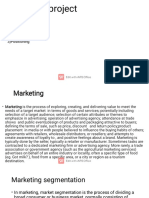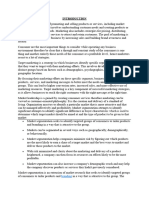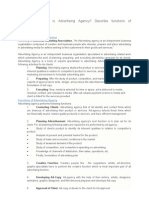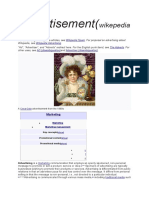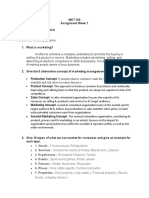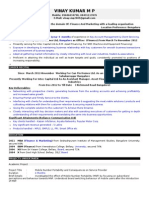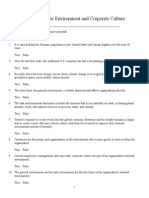Marketing Management
BBA-II
� Segmentation , Targeting and Positioning
Segmentation:
• Segmentation refers to the process of dividing your audience into
smaller groups based on certain characteristics.
• A strategy that involves dividing a target market into groups based
on shared characteristics
• The goal of market segmentation is to create tailored marketing
campaigns that are more relevant and appealing to each
group. This can help businesses differentiate their focus points and
priorities, and reach their target audience more effectively.
• Market segmentation seeks to identify targeted groups of
consumers to tailor products and branding in a way that
is attractive to the group.
�Basses of Segmentation:
• Demographics, which typically answer the question
of who your buyer is (e.g. age, gender, education, location,
and profession)
• Psychographics, which answer the question of why your
buyer buys (e.g. priorities, personality traits, and beliefs and
values)
• Lifestyle traits, such as hobbies, entertainment preferences,
and non-work activities
• Behavior, such as brand loyalty, channel preferences, and
other shopping habits
�Targeting:
• A target market is a group of people that have been identified
as the most likely potential customers for a product because
of their shared characteristics, such as age, income, and
lifestyle.
• A target market is a group of customers with shared
demographics who have been identified as the most likely
buyers of a company's product or service.
• The target market also can inform a product's specifications,
packaging, and distribution.
�Benefits of Target Market:
• Better marketing performance
• Market targeting can help businesses achieve better results by reaching the
right people with the right message at the right time.
• Stand out from competition
• By identifying your target market, you can learn about your competitors'
demographics and tailor your marketing to your audience.
• Increase customer loyalty
• Personalized marketing can help increase customer engagement and loyalty.
• More efficient marketing
• By targeting the right people, you can avoid wasting money on campaigns
that won't be effective.
• Develop stronger products
� Bases of Target Market
Basis of Target Marketing
• Age
• Gender
• Interests
• Geographic location
• Need
• Occupation
Why target marketing? (Need of Target Marketing)
• Organizations can use similar kind of strategies to promote their products within a
target market.
• They can adopt a more focused approach in case of target marketing. They know
their customers well and thus can reach out to their target audience in the most
effective way.
��• By understanding your customers better, you can create products
that appeal to specific groups.
• Improve customer relations
• Customer engagement marketing can help build better customer
relations, which can lead to more sales and positive feedback.
• Cost-effective marketing
• Digital marketing can be cost-effective, and precise targeting can
help you budget your marketing spending.
�Positioning:
• Market positioning is a strategic process that helps a company
establish a unique image for its brand or product in the minds
of consumers. It's a crucial part of a marketing plan that can
help a business gain a competitive advantage and increase
sales.
• Market Positioning refers to the ability to influence
consumer perception regarding a brand or product relative to
competitors. The objective of market positioning is to
establish the image or identity of a brand or product so that
consumers perceive it in a certain way.
�Types of Positioning Strategies
There are several types of positioning strategies. A few examples
are positioning by:
• Product attributes and benefits: Associating your brand/product
with certain characteristics or with certain beneficial value
• Product price: Associating your brand/product with competitive
pricing
• Product quality: Associating your brand/product with high quality
• Product use and application: Associating your brand/product with
a specific use
• Competitors: Making consumers think that your brand/product is
better than that of your competitors
� Need for Market Segmentation
Precision in Marketing
• Market segmentation allows businesses to target their messages precisely.
Rather than adopting a one-size-fits-all approach, they can tailor their
offerings and communication to specific segments, improving the overall
effectiveness of their marketing campaigns.
Better Customer Understanding
• Understanding your customer is key to any successful business. Through
segmentation, a business can better understand the needs, desires, and
behaviors of its target market, thereby enhancing customer satisfaction and
loyalty.
Efficient Resource Allocation
• With the right segmentation, you can ensure your resources are allocated
effectively. Marketing budgets can be used optimally, targeting those
segments that are most likely to yield a return on investment.
�Competitive Advantage
• Market segmentation can also provide a competitive advantage.
Understanding the unique characteristics of your market segments allows
you to offer tailored products or services that meet their specific needs,
differentiating your business from competitors.
Improve Product Development
• By understanding the different segments, businesses can improve their
product development process. They can develop products that specifically
cater to the needs and preferences of each segment.
Enhance Customer Retention
• Customer retention is often enhanced when a business can meet its
customers’ specific needs. Market segmentation allows for this by
enabling businesses to identify the unique needs and wants of different
customer groups.
� Product differentiation
• Product differentiation is a marketing strategy used by businesses to distinguish their
products or services from those of competitors. This can involve highlighting unique
features, benefits, or attributes that make a product more appealing to consumers.
Product differentiation Strategies:
• Features and Quality: Differentiating products based on specific features,
functionality, or superior quality. For example, a Smartphone may offer a better
camera, longer battery life, or advanced software.
• Design and Aesthetics: Unique design elements or visual appeal can set a product
apart. Brands often invest in distinctive packaging or stylish designs to attract
customers.
• Branding: Strong branding creates an identity for a product, influencing customer
perception. A well-recognized brand can lead to a preference for its products over
less-known competitors.
• Customer Service: Offering superior customer service can differentiate a company.
Excellent support, easy returns, or personalized experiences can enhance customer
loyalty.
�• Price: Positioning a product as a premium option or a budget-
friendly alternative can serve as a differentiation strategy. Luxury
brands often emphasize exclusivity, while discount brands focus on
affordability.
• Target Market: Tailoring products to meet the specific needs or
preferences of a niche market can effectively differentiate them. For
instance, organic products cater to health-conscious consumers.
• Innovation: Regularly introducing new and innovative products can
keep a brand ahead of competitors. This can include adopting new
technologies or developing new solutions.
• Sustainability: Emphasizing eco-friendly practices and sustainable
sourcing can attract environmentally conscious consumers, setting a
product apart in the market.
� Market Aggregation
• Market aggregation is a way of selling products where a
company treats all customers as one big group instead of
dividing them into smaller groups. The company offers the same
product to everyone without making changes for different
people.
• Market aggregation" or "undifferentiated marketing" is a strategy
that treats the entire market as a single, homogenous group,
ignoring differences in customer needs or preferences, and
targeting all customers with the same product and message.
Examples:
• Coca-Cola using the same branding and product worldwide.
• Apple iPhones, which appeal to a general audience rather than a
niche market.
�Key Features:
• Mass Marketing Approach – Focuses on a large
audience rather than specific segments.
• Standardized Product – Offers the same product
to all customers without differentiation.
• Cost Efficiency – Reduces production and
marketing costs due to economies of scale.
• Broad Target Market – Aims to capture the
largest possible customer base.
�Advantages:
✔ Lower marketing and production costs.
✔ Strong brand recognition due to uniform messaging.
✔ Higher sales volume due to a broad customer base.
Disadvantages:
✖ Lack of customization may not meet specific
customer needs.
✖ High competition from niche-focused businesses.
✖ Risk of missing market opportunities in specialized
segments.
� Segmentation of Consumer/ Industrial markets
1. Consumer Market Segmentation
Consumer markets consist of individual buyers who purchase products
for personal use. Segmentation can be done based on:
• Demographic Segmentation – Based on age, gender, income,
education, occupation, etc.
– Example: Kids’ toys for children, luxury cars for high-income individuals.
• Geographic Segmentation – Based on location such as country, city,
climate, etc.
– Example: Warm clothing brands targeting cold regions.
• Psychographic Segmentation – Based on lifestyle, personality, values,
interests.
– Example: Fitness brands targeting health-conscious individuals.
• Behavioral Segmentation – Based on buying habits, brand loyalty, and
product usage.
– Example: Discount offers for frequent shoppers.
�2. Industrial Market Segmentation
Industrial markets (also called business markets) consist of businesses that
buy products for production, resale, or operations. Segmentation here is
based on:
• Firmographics – Based on company size, industry type, revenue, location.
– Example: A software company selling business tools to large corporations.
• Operating Variables – Based on technology, production process, or user
requirements.
– Example: A machinery supplier catering to automotive and textile industries.
• Purchasing Approach – Based on decision-making process, supplier loyalty,
or price sensitivity.
– Example: A company offering bulk discounts to large businesses.
• Situational Factors – Based on urgency, order size, or specific business needs.
– Example: A raw material supplier prioritizing urgent orders for manufacturers.
� Basis for identifying target customers
To find the right customers for a business, consider these factors:
• Personal Details – Age, gender, income, job, education, and family status.
• Location – Where they live, the weather, and if they are in a city or village.
• Lifestyle & Interests – What they like, their hobbies, and their values.
• Shopping Habits – How often they buy, what brands they prefer, and how
they use products.
• Needs & Problems – What issues they face and how the product can help.
• Competition – Who other businesses are selling to and any gaps in the
market.
• Money Matters – How much they can afford and are willing to pay.
• Technology Use – If they shop online, use apps, or prefer digital services.



































